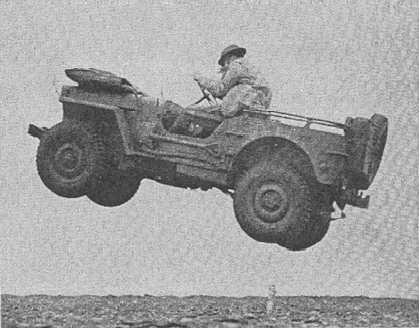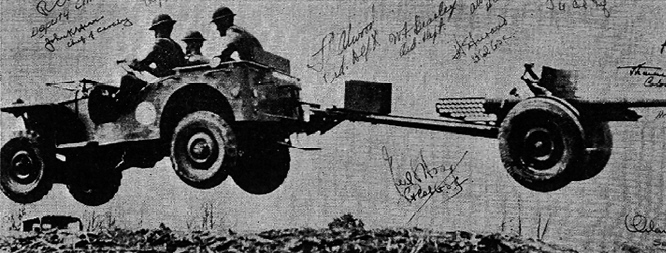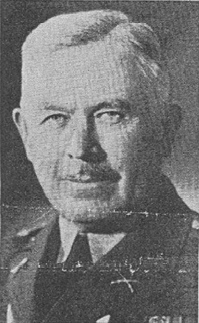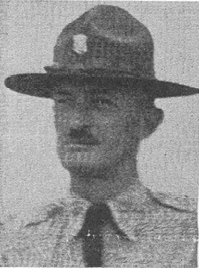

Original Source Documents: August 1942 - The Story Behind the Army Jeep - Illustrated Gazette - Vol 1 No 4 - pg.1,2,6,8
Contributor: Robert Notman
Source: U.S. Army Military History Institute

THE STORY BEHIND THE ARMY JEEP
Now Famous Blitz Buggy Was Black Sheep of Army in '40
By JOHN W. CHAPMAN
Copyright 1942
This story of the Jeep is copyrighted and its reproduction in whole or part without permission of the copyright owner is strictly forbidden. Editors of responsible newspapers and magazines may obtain reprint privilege upon written request.
NOT OFFICIAL
In presenting this heretofore unpublished story, the writer assumes that the disclosures made by Col. W. F. Lee, U. S. A., and Mr. C. H. Payne regarding the development of the Jeep are correct.
|
In a letter addressed to C. H. Payne and dated May 19, 1942, General George A. Lynch, former Chief of Infantry said: "I hope you are able to establish proper credit for the development of the Jeep. This, I think, should be divided between yourself and Colonel Lee."
|

Its a quarter-ton runt with a mechanical heart and a steel constitution; it has more speed than a backfield full of All-Americans; it can climb mountains; it can fly; it can swim; it can jitterbug across rough terrain at 50 miles an hour, hauling four armed soldiers and a 37 min gun with the same ease a hound dog carries fleas, and it is the first silk stockingless subject to enter a conversation whenever two or more Army men get together.
"It" is the Jeep, obviously.
But this is not another glorified feature story concerning the Army's favorite blitz buggy. This is THE story of the Jeep ... this is the horse which has been following the cart for two long years.
The 'horse' on us is that the jeep is not the brainchild of Willys-Overland and Army Quartermaster "experts" as the car company's advertisements in magazines and newspapers attest.
The jeep, in fact, was born of a civilian who turned Army red tape into a pale pink and an Army officer who knew what the Infantry needed in the line of a fast, durable combat car.
Our real heroes, it fact, are former Navy pilot Charles Harry Payne and Col. W. F. Lee, Infantry, who, in the words of the latter, are "finding misrepresentations of facts by Willys-Overland and other parties extremely distasteful" and believe it is high time that the truth about the jeep he made known.

“AS TO THE RIDING QUALITIES OF THE JEEP, A CHIROPRACTOR SHOULD BE STANDARD FOR EACH CAR” That was the statement made by Charles H. Payne, the man who is mainly responsible for the Jeep’s development. The above picture showing the famous blitz buggy flying through the air towing a 37-mm gun, bears Payne out. The photo from which this engraving was made was autographed by carious army officers acquainted with the Jeep’s development.
This sentiment was expressed by Colonel Lee in the chronology of the jeep he prepared for Maj. Gen. George A. Lynch, Chief of Infantry, under whom Lee served as officer in charge of new developments for the Infantry.
It was General Lynch who signed the official letter setting up the requirement for the Jeep. Retired a year ago and now living in Orlando, Fla., the general serves as one of this writer's authorities for the surprising facts presented for the first time in this story.
Foremost among these facts are:
1. That officers of the QMC attempted to "sabotage" the first jeep test order.
2. That officers in the other Arms and Services of the Army originally showed no interest in "that type" of car.
3. That former Secretary of War Harry Woodring was sympathetic to the jeep idea and raised you-know-what with the QMC when he learned that they had tried to defeat Payne s promotion of that vehicle.
4. That Willys-Overland - now the only company manufacturing the jeep in quantity - a month before the jeep idea came to light emphatically refused to produce a half-ton truck of lower silhouette because it required modification of their standard cars.
5. That the Bantam Car Company of Butler, Pa., for whom Payne got the first order for 3,000 Jeeps, cast its ace salesman aside after he had virtually saved the company, and then in a twinkling lost out entirely when Willys-Overland came up with a ridiculously low bid on 16,000 machines.
6. That the same officers who ridiculed the jeep idea openly in the beginning and referred to Payne as an "annoying pest" were the first to claim shares of credit in the development of the car after its seen rational performance on the testing ground at Holabird, Md.
With the exception of its weight, which was changed several times in the course of assembly, the Jeep as we see it today retains all of the features originally contributed by Payne and Col. Lee.
While the Jeep's characteristics easily distinguish it from its many cousins in the car field, it cannot be considered an altogether brand new idea.
Before the Bantam Car salesman and the Infantry officer got their mechanically indicted minds together and came up with what is now the most famous car since "Johnny Verbeck's Machine", Colonel Lee was seeking the support of the QMC, the Cavalry, the Artillery and others for the purchase at two Gantz (Germans make) cars which had been tested with good results by the British and French, and Payne - acting in official capacity of the Bantam Car company - was attempting to sell the Infantry a small machine gun car developed by Major Robert Howie and General Short and known as the "Howie Carrier."

Maj. Gen. George
A. Lynch
Said Infantry Needed Jeep

Col. William F.
Lee
He Ate, Slept and Talked Jeep
Army Cold On "Runts"
Literature and extracts from reports of tests of the Gantz car had been received from the U.S. Military attaché in Switzerland and referred to the Chief of Infantry for comment. But Lee found his own office cool on the Gantz car purchase and the other Arms and Services frigid.
On the other hand, the Howie Carrier, a low silhouette car whose design required its two soldier passengers to lie prone on their stomachs behind the gun, got the thumbs down verdict of the Infantry Board following stiff tests to determine its value as a combat car.
In the meantime, Col. Imoger Oseth, No. 3 man in the office of the Chief of Infantry, had been pushing the Quartermaster General to effect a reduction in the silhouette of the half-ton truck. In May, 1940, he asked representatives of the Willys-Overland company to produce a half-ton truck of lower silhouette than the one then in use by the Infantry. But the W.O. men refused, making it clear to Colonel Oseth that they would have nothing to do with any work calling for modification of their standard vehicles.
Payne Arrives On Scene
On June 5, 1940, Payne visited the office of General Lynch for the first time to investigate rumors of a contract to be let by the War Department for the manufacturer of Howie Carriers. The former Navy officer said he had been told that the Chief of Staff was interested in providing Howie Carriers for the Army in large numbers.
"Oseth and I were familiar with the powers and limitations of the Howie Carrier." wrote Lee to his chief, "and tried to point out to Mr. Payne that we could be of no assistance to him in his efforts to promote that vehicle. After about two days of warm discussion, he began to show signs of understanding that the Howie Carrier... was not suitable for combat use."
It was at this point that Payne and Colonel Lee began putting their ideas together for the now famous Jeep, and Lee's report said that "Payne was very enthusiastic from the start, and continued to maintain an optimistic attitude toward the final results in spite of the many obstacles, technical and administrative, in his path." While Payne was primarily interested in getting business for his company, Lee said, he also showed keen interest in doing what he could to help the Infantry develop the car it needed.
After most of the details for the Bantam had been worked out, it was necessary for Col. Lee and Payne to get the support of the other Arms and Services before submitting the project in final form to General Lynch. Having previously found the other departments ice cold on the Gantz car, Lee soon learned that they were far from a thaw on the subject of any light car, including this new thing - this mechanical bulldog then referred to as the Bantam.
Cavalry Only Supporter
Surprising in the light of the Jeep's current popularity in the Army is the fact that of all the Arms and Services only the Cavalry could be induced to support the Bantam. And even this small support was of a compromising nature. For Maj. Frank Tompkins, acting for Col. John Herr, his chief, said that the Calvary was not interested in the Infantry car but would support the idea if the Infantry, in turn, would support a project then being prepared by the Cavalry.
The Quartermaster General's Office was not interested in the Bantam but said that they would not interpose serious objection if the Infantry wanted the car. "None of the others, including the Field Artillery, would join us." Lee revealed.
Inasmuch as the Infantry had experienced difficulty in getting the Quartermaster General's office to effect modification of transport, General Lynch approved Colonel Lee's proposal to place the project under the Ordnance department.
Colonel Lee took the matter up with Colonel Barnes, Ordnance, and found him agreeable to the idea. Colonel Barnes, now a brigadier general, suggested that the requirement for the Jeep include a small strip of iron plate far the windshield in order that the project could be designated as an Ordnance job.
This suggestion was quickly followed and the project referred forthwith to the Chief of Ordnance.
Payne Called 'Pest'
During this preliminary stage, when the work consisted mainly of selling the light combat car to representatives of the principal Arms and Services, Payne at first enjoyed splendid success. Later, however, he met with strong opposition from some quarters and it remained Lee's task to smooth out the difficulties. The general opinion of Payne, according to Lee's report, was that he was an "annoying pest" with only an ordinary car to sell.
After a week of continuous campaigning, Lee and Payne drew up the characteristics of the Jeep. When the letter setting up the requirement for the car was in the process of being drafted, General Lynch authorized Colonel Lee to add a paragraph recommending the development of the amphibious feature.
Colonel Lee and his chief had discussed the possibility of a amphibious vehicle many times before the Jeep idea evolved. On this subject, Lee reported to the general "Your prompt and emphatic approval of my request to the amphibious feature in the letter to the Adjutant General gave me a thrill that will always remain in my memory in connection with the development of the Bantam car."
In the meantime, Payne wasn't twiddling his thumbs. Opposition the Bantam and himself was strong, and his ability as a salesman was being tested to the utmost. He became entangled in red tape and fought free of it time and again. On various occasions he even found it difficult to get past an unfriendly executive officer to see General Lynch, and officers in the other Arms and Services practically shoved him out of their offices one minute only to find him in again the next.
No one man ever encountered stiffer mass opposition in Washington and came out with his colors flying higher than Payne.
Col. Lee Praises Payne
In the summation of his report, Lee paid this tribute to his fellow Jeep man:
"Some may say that he (Payne) was motivated entirely by selfish interests and will try to discredit him for that reason, but the hard fact remains that he rendered outstanding service to our Army in transport development at a time when such service was almost non-existent, not to mention the obvious benefits derived from its development from many stand points.
Payne's Coup de grace was the winning over to his side of former Secretary of War Harry Woodring. Woodring listened to Payne's story and went into immediate action when all the facts were at his fingertips. According to Payne, the Secretary of War called the QMC on the carpet for attempting to "sabotage" the Jeep test order, and then set about cutting red tape in order that Payne might get expeditious action on the Infancy letter. Major Tate was assigned the exclusive duty of assisting Payne and Lee, and his appearance on the scenic resulted in more favorable attention being directed toward them from quarters previously antagonistic.
On June 19, 1940, the Ordnance Technical committee, of which Colonel Lee was a member, visited the Bantam Car company plant at Butler, Pa., for the purpose of determining whether the company could do as it claimed toward manufacturing the light car.
Find Bantam Improved
The committee found the commercial Bantam a much improved car over the model test a few years before by the Infantry Board. The committee also reported the company was apparently in poor condition with respect to current business it had adequate facilities to turn out the car recommended for development.
When the technical committee returned to Washington on June 21 a formal meeting was held with all Arms and interested Services represented. Recommendations of the committee was that the project for the development of the quarter-ton truck as set up in the Infantry requirement letter be approved, and that the project be transferred back to the Quartermaster General.
It is the writer's humorous observation here that the Jeeps ability to "take it" was the result of a stormy pre-natal period, during which its embryo was tossed back and forth between the QM and Ordnance departments like a hot potato.
Not many hours after the June 21 meeting broke up, a rough design of the Bantam was made in General Lynch's office. It was submitted to a new committee which met at the Butler, PA. car plant in early July. This historic get-together included Payne, Frank Fenn, president of the Bantam company, and Bantam's chief engineer, J. Prost. The committee was formed by Colonels Lee and Oseth, Infantry; Colonel L. J. Atwood (Chief of Cavalry), Mr. W. F. Beasley of the Ordnance department and a civilian employee of the QM office on duty at Holabird.
An outline of the body of the car was drawn on the floor of one of the buildings and later a mock-up was prepared, following almost exactly the drawing made in General Lynch's office days before.
Payne and his engineer made exhaustive notes from the mock-up and reviewed the characteristics of the car from various technical angles. From the time of the approval of the project by the War Department to the time of the delivery of the Bantam pilot model at Holabird, there were several adjustments in the weight of the car, partly as a result of materials used but largely because of changed in the front drive and transfer case.
Made in 49 Days
There followed days of concentrated effort on the part of Bantam engineers and mechanics at the Butler plant, and while August was yet blistering the necks on the sentries at Holabird, in through the main gate rolled the grandfather of all snub-nosed Jeeps. It had been manufactured in exactly 49 days.
There were no bands on hand that day to greet the homely midget. But there was a goodly crowd ... of skeptics. The Infantry was there in large numbers, mingling with tongue-in-cheek representatives of the Cavalry, Field Artillery and Armored Force, whose services, as a result of the June 21 meeting in the Capital, were to share equally in 30 of the 70 cars recommended for manufacture by the Infantry.
It was the Jeep's "coming out" party in military society - and what a party! The program consisted of a series of tests designed to give the car the same punishment in 500 miles that it would normally get in 10,000 miles. But the Bantam was a tough debutante.
Its wheels were spin on starts. Then it was sent over a series of ditches at high speed and up 60 degree grades. A corrugated road, with a reputation of being able to shade the spots off loaded dice, next confronted the on rushing car, but the Jeep took it in stride without batting a headlight. At this point in the proceedings, it seemed that most of the observers had to control themselves from running up to the car and planting kisses on its undamaged steel hide.
At last, there was only one more obstacle left - "General Mud." Many tomes over the nemesis of machines whose giant mechanical statures alongside the Jeep would make it appear as a toy. It was a brief battle, with the Bantam churning the mire all over the field. The acclaim was unanimous.
Critics To "About Face"
Worthy of special note at this juncture of the jeep's chronology is the quick "about face" executed by the same officers whose lack of interest in the Bantam in the beginning prolonged its development. These short sighted individuals vied with each other in complimenting the performance of the blitz buggy, and sought to find instances during its development which would associate them more closely with the Jeep than their fellow officers.
In fact, Colonel Lee and Payne were made to feel like the two swains who brought their mutual girl friend to a party and saw her swept away by the stag line.
From Holabird on, it was the Quartermaster General's "baby," and the two men whose unshaken faith and determination and brought the Jeep into national limelight suddenly found themselves engulfed by official darkens.
From Holabird on, too, the Willys-Overland company experienced a change of heart for, while most of the observers at the Jeep Party were oh-ing and ah-ing and raising their eyebrows, Barney Roos, chief engineer of the Willys-Overland company, was seen making a minute inspection of the car and filling what Colonel Lee described in his notes as a "little black notebook".
The significance of the Willys-Overland engineers' presence at Holabird that eventful day was fully illuminated months later when his company "horned in" with what Payne terms a "ridiculously low bid' on 16,000 Jeeps and thereby stopped the Bantam Car company's production of the combat car at the 3,000 mark.
It was rumored soon thereafter that Willys-Overland for the new contract as the result of a very good "in" with John Biggers, then the head man of OPM. This revelation brought the Truman committee on the scene at a gallup and Biggers and the QMC on the proverbial carpet. Shortly after the Truman investigation, Biggers was let out of OPM.
The writer mentions the above only because it amounts to an anomaly in the case of Payne, who despite his strong connection with the Jeep, was something of a disinterested party at the Truman investigation.
Payne's non-active position in the investigation was the result of the Bantam Car company "canceling my contract after I had accomplished the first order for 3,000 Jeep and virtually put the company back on its feet." Payne reveals that he never was an official of the Bantam company but acted as "assistant to the president."
In reviewing his misadventures as the Jeep man, Payne recalls that his first drawing showed the car carrying a machine gun. After many conferences, he said, it was decided to get the car built and running and skip the idea of armament until the car was proved up. "Unfortunately," Payne says, "I have to deal with the Quartermaster Corps who laughed at my ideas... this is where the fight started."
Payne's toughest campaign was dated from June 22, 1940, when the Jeep project was approved, until July 11, when the Quartermaster General's office mailed bids on the first 70 cars to the Bantam Car company. During this period, Payne sought to get quick action on the contract and to this end his energy knew no bounds. He repeatedly called on the G-4 staff officers and the Secretary of War's, the Chief of Staff's and the QM General's offices, informing one and all that the Infantry wanted cars for fall maneuvers.
Wanted to See Jeep Star
The officers he contacted miscomprehended the motive behind Payne's frequent visits. The almost unanimous and erroneous opinion was that Payne was in a hurry to get his commission on the deal in his wallet. The truth of the matter, however, was that Payne wanted to see the jeep do what he knew it was capable of doing before the admiring eyes of the entire Army. The fall maneuvers presented a broad stage, and he wanted to see the Jeep play the lead in this mammoth make believe drama.
In closing the chronology of the Jeep, Colonel Lee said:
"All only interest in the development of the car was to contribute something useful for Infantry combat and I believe that what I have done toward the project warrants the assumption of some credit for a fair share of that contribution. I have not made a definite effort to obtain such credit nor did I believe I should make such effort... What can be done will probably be started by Mr. Payne because it means a livelihood to him. I would like to see him rewarded for the results he obtained because he helped us produce the car we knew was greatly needed."
In a letter addressed to Payne and dated May 19, 1942, General Lynch endorsed the statements made by Colonel Lee in the history of the quarter-ton truck, which served as a guide for the writer, and said: "I hope you are able to establish proper credit for the development of the quarter-ton truck. This I think should he divided between yourself and Colonel Lee."
If it were left to either of the real Jeep men - Charles Harry Payne and Col. W. F. Lee - to break this true story of a great contribution at a critical time in our military history, the writer doubts that it ever would have gotten into print.
The fact that this story has been wrapped up for two years, and is now revealed only through General Lynch's cooperation with the writer testifies to the character of the Jeep men - character as strong as the car that evolved from their mechanically-inclined minds.